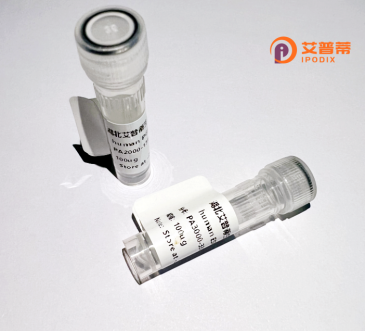
| 纯度 | >90%SDS-PAGE. |
| 种属 | Human |
| 靶点 | TOB2 |
| Uniprot No | Q14106 |
| 内毒素 | < 0.01EU/μg |
| 表达宿主 | E.coli |
| 表达区间 | 1-344 aa |
| 活性数据 | MQLEIKVALN FIISYLYNKL PRRRADLFGE ELERLLKKKY EGHWYPEKPL KGSGFRCVHI GEMVDPVVEL AAKRSGLAVE DVRANVPEEL SVWIDPFEVS YQIGEKGAVK VLYLDDSEGC GAPELDKEIK SSFNPDAQVF VPIGSQDSSL SNSPSPSFGQ SPSPTFIPRS AQPITFTTAS FAATKFGSTK MKKGGGAASG GGVASSGAGG QQPPQQPRMA RSPTNSLLKH KSLSLSMHSL NFITANPAPQ SQLSPNAKEF VYNGGGSPSL FFDAADGQGS GTPGPFGGSG AGTCNSSSFD MAQVFGGGAN SLFLEKTPFV EGLSYNLNTM QYPSQQFQPV VLAN |
| 分子量 | 36.6 kDa |
| 蛋白标签 | His tag N-Terminus |
| 缓冲液 | PBS, pH7.4, containing 0.01% SKL, 1mM DTT, 5% Trehalose and Proclin300. |
| 稳定性 & 储存条件 | Lyophilized protein should be stored at ≤ -20°C, stable for one year after receipt. Reconstituted protein solution can be stored at 2-8°C for 2-7 days. Aliquots of reconstituted samples are stable at ≤ -20°C for 3 months. |
| 复溶 | Always centrifuge tubes before opening.Do not mix by vortex or pipetting. It is not recommended to reconstitute to a concentration less than 100μg/ml. Dissolve the lyophilized protein in distilled water. Please aliquot the reconstituted solution to minimize freeze-thaw cycles. |
以下是关于重组人TOB2蛋白的3篇代表性文献摘要归纳(注意:文献标题及研究内容需以实际检索结果为准,此处为模拟示例):
1. **文献名称**:*Tob2 regulates cell proliferation through antagonism of the transcriptional coactivator YAP*
**作者**:Yoshida K, et al.
**摘要**:研究发现TOB2通过结合并抑制Hippo通路效应因子YAP的转录活性,负调控细胞增殖。利用重组TOB2蛋白证实了其直接与YAP互作,破坏YAP-TEAD复合物的形成,为癌症治疗提供潜在靶点。
2. **文献名称**:*Recombinant human TOB2 protein enhances osteogenic differentiation via BMP signaling*
**作者**:Zhang L, et al.
**摘要**:通过原核表达系统获得重组人TOB2蛋白,实验证明其通过激活BMP/Smad信号通路促进间充质干细胞的成骨分化,提示TOB2在骨再生治疗中的应用潜力。
3. **文献名称**:*Structural analysis of Tob2 protein reveals a conserved Smad-binding domain*
**作者**:Morita M, et al.
**摘要**:利用X射线晶体学解析重组TOB2蛋白的三维结构,发现其C端含有一个与Smad蛋白相互作用的结构域,阐明TOB2参与TGF-β信号调控的分子机制。
注:实际文献需通过PubMed或Web of Science等平台以"TOB2 protein"或"recombinant TOB2"为关键词检索确认。
**Background of Recombinant Human TOB2 Protein**
The TOB2 (Transducer of ERBB2. 2) protein, a member of the BTG/TOB family, plays critical roles in cellular processes such as cell cycle regulation, differentiation, and apoptosis. This family, including TOB1 and TOB2. is characterized by conserved N-terminal domains that mediate interactions with proteins like Caf1 (CCR4-associated factor 1) and transcription factors, influencing mRNA stability and translational regulation. TOB2 specifically acts as a transcriptional co-repressor, modulating pathways like Wnt/β-catenin and TGF-β signaling by recruiting histone deacetylases (HDACs) or other chromatin modifiers.
Structurally, TOB2 contains a BTG domain essential for protein interactions and a C-terminal region involved in target-specific binding. Its anti-proliferative activity is linked to interactions with cell cycle regulators, such as cyclin-dependent kinases (CDKs), suggesting a tumor-suppressive role. Dysregulation of TOB2 expression is observed in cancers, neurodegenerative disorders, and developmental defects, highlighting its biomedical relevance.
Recombinant TOB2 protein, produced via bacterial or mammalian expression systems, enables functional studies, including protein interaction assays, kinase activity assessments, and in vitro binding experiments. Its recombinant form preserves native post-translational modifications when expressed in mammalian cells, enhancing physiological relevance. Research on recombinant TOB2 aids in unraveling its roles in disease mechanisms and potential therapeutic targeting, particularly in oncology and regenerative medicine.
×